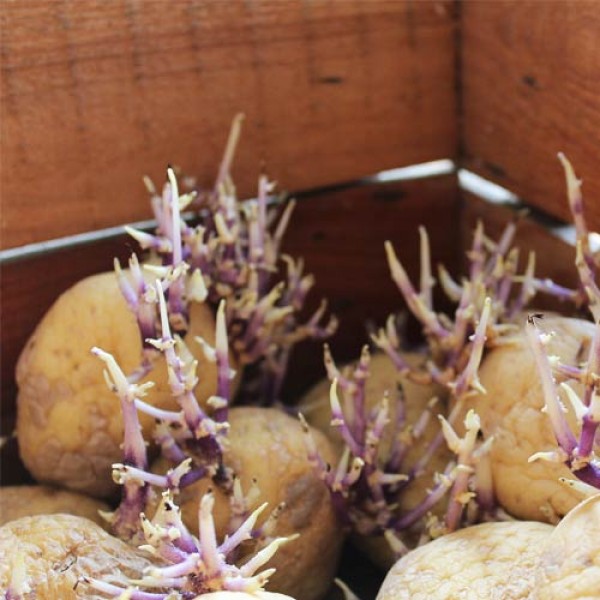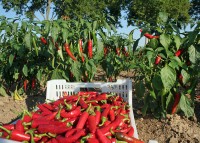Grow your own potatoes
Location
The potato wants a sunny location. In the garden, the potato therefore needs a bright and warm place. The soil should be well-drained and light or moderately heavy. Potatoes do not like waterlogging. Heavy clay soils can be loosened with sand. If potatoes are planted in "poor" soil, the harvest will be smaller. Fertilisation can improve the soil quality.
Sowing and care
Potatoes are not sown or pre-sown in the true sense of the word, but are planted as seed potatoes. Pre-sprout the potatoes from mid-February to the beginning of May.
To let the potatoes pre-sprout, place them open in a cool place, such as the cellar. Exposure to light will stimulate the potatoes to form shoots.
Important! Only use healthy potatoes! Sort out rotten potatoes completely!
From mid-April to June at the latest, plant the potatoes in trenches at a depth of 8 to 10 cm, preferably. If the soil is very dry, water the potatoes.
The distance should be at least 30 - 40 cm. When planting, make sure that the shoots point upwards and do not break off.
If you have compost in the garden, you can use it to fill the trenches, otherwise use normal garden soil.
The first step after planting the potatoes is to level the trenches.
The soil should not be pressed down too hard. A loose soil improves the growth of the potato plants.
In the next step, the ridges are heaped up. This is necessary for the new potatoes to form in the ridges. Here they are protected from sunlight. The mounding is repeated two to three times until the potato plants have grown about 10 cm high.
This is important so that the potatoes are always covered with enough soil.
Use a rake to mound the soil above the rows on both sides, this should create an even ridgeline. The base should be wider than the top. The potato belongs to the group of heavy growers and needs fertiliser before planting and when the fruits are formed.
Well-rotted horse or cow dung, for example, is suitable as fertiliser. Fresh manure should not be used, it is too harsh and can damage the seed potatoes on direct contact or attract wireworms.
If you have limited space in the garden, you can also use so-called potato towers, such as the Paul Potato tower.
Harvest:
When flowering begins, the potato plant forms small tubers in the soil. These can be harvested as small potatoes. If you wait until the flowering period, the potatoes will gain a lot of weight. For this reason, it is common to wait for the potato plants to wilt and turn brown before harvesting them. Once the plant has wilted, it is the ideal time to harvest the potatoes.
The potatoes that are ready for harvesting lie under the main shoot in a radius of about 50 - 60 cm. A spade or digging fork is best for digging up. Under optimal conditions, you can get about 10 kg of harvest from 1 kg of seed potatoes.
Caution: If the potato tubers are too close to the surface and have turned green, they should not be eaten. Green tubers contain the poisonous solanine.
Storage:
If the potatoes are to be stored, harvest them on a dry day and let them dry in the sun for a few hours. Sort out damaged tubers before storing.
The remaining tubers should be stored in a cool and dark place such as the cellar or a storage room. The refrigerator is not a suitable storage place, it is too humid!
The ideal storage temperature is 4 - 12 °C.
If it is colder, the starch contained in the potatoes converts into sugar.
If it is warmer, the potatoes begin to germinate.
Store apples and pears separately, they cause the potatoes to spoil more quickly.
Baskets, crates and linen bags are suitable storage containers; air can circulate in these.
Diseases & pests:
Many potato diseases are widespread. They range from harmless bacterial infections to notifiable fungal diseases. The most important thing is to recognise the damage in time to be able to help.
For the prevention of potato diseases, one should always pay attention to healthy seed potatoes and choose resistant potato varieties if possible. If you observe crop rotation and potato breaks in the field, the potatoes will have a good start right from the start.
Plants and tubers affected by diseases should be safely disposed of in the residual waste and not in the compost, this will prevent them from spreading. When harvesting, always use only clean tools and do not damage the tubers.
After harvesting, store the potatoes properly and check regularly for rotten potatoes.
The most common pests that affect potatoes are: Potato beetles, wireworms, aphids, slugs or field mice.
The most common potato diseases:
1. late blight
Most common potato disease. Very old fungal disease. The fungus needs a moist environment to spread. There is a risk of infection as soon as the leaves are formed, and in warm, humid conditions the fungus spreads very quickly.
2. potato scab
Potato scab is caused by bacteria called Streptomyces scabies. This occurs throughout Germany. However, the bacteria mainly attack potatoes grown on light sandy soil. The bacteria penetrate the still growing tuber. Infection usually takes place during the first 14 days of tuber growth. The pathogen of potato scab depends on a lot of oxygen. Therefore, it has an easy time infecting the potatoes, especially in very loose soils. The bacteria can also develop better at higher pH values, so that potato scab rarely occurs at values below 5.5. There is hardly any crop loss and the taste of the tubers does not suffer either. Pests penetrate more easily in scabbed areas, but there are usually no further losses here. If such potatoes are stored later, they shrink faster.
3. blackleg disease
The potato disease blackleg is also caused by bacteria and can occur more frequently in potato plants. But only when a certain degree of infestation is reached do we have to expect crop losses. Infection with blackleg is more common on heavy soils, as waterlogging often occurs on these soils. Potato varieties that are more frequently affected include Nicola, Satina and Adretta.
4. drought spot disease
Drought spot disease is a fungal infection that occurs mainly in dry, warm summer weather. Tomatoes can also be affected by drought spot disease.
5. potato canker
Potato canker is also caused by a fungus, Synhytrium endobioticum. It attacks the tubers and the base of the stem.


















